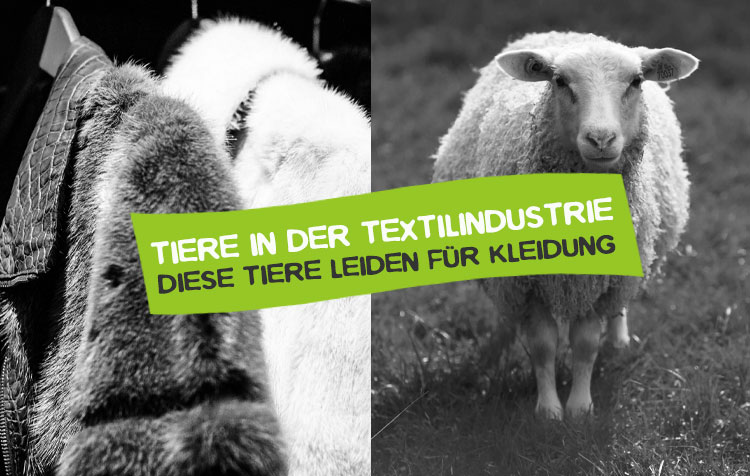You want to know more about animals in the textile industry and which fabrics are of animal origin? Then you've come to the right place! A thick almond made of real fur, an elegant dress made of silk, a lined down jacket or a comfortable sofa made of leather - all these textile pieces tell the story of an animal. Yet we wear and use them as if they were ordinary everyday products. Yet for each of these products, a sentient creature had to suffer. Unseen behind closed cage doors.
With this article I would like to tell you everything you need to know about animal suffering in the clothing and textile industry and, above all, make you aware of the consequences of your purchasing decisions in fashion stores. You'll learn which fabrics are of animal origin, which animals are exploited for textiles and what you can do about it in your everyday life. Let's go!
Here you can find a short overview in advance:
For which textiles and fabrics do animals have to suffer?
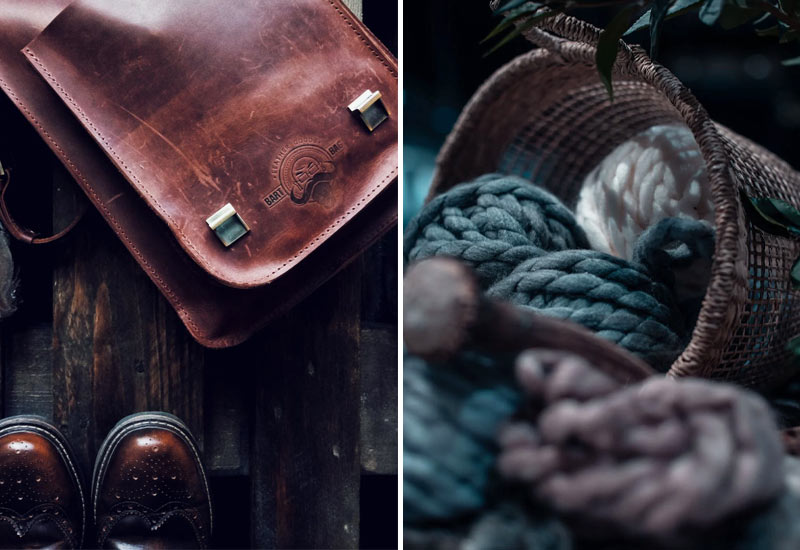
There is a real variety of textile materials that are animal in nature. Nowadays, in order to be able to guarantee this material permanently, the animals are hardly ever caught in the wild, but are to a specific "purpose (which we humans have assigned to them out of self-interest). bred towards.
And so, over time, industries have emerged, especially for the following substances, that exploit animals according to plan (and still socially accepted):
- Leather
- Fur
- Silk
- Down
- Wool
- …
These are the fabrics you should avoid in your clothing choices - whether you're live vegan or just want to prevent animal suffering in general.
But now I would like to explain to you in more detail what exactly has to happen to the animals so that you can end up wearing a leather handbag, a fur coat, a silk dress, a down jacket or a wool hat. Afterwards, you'll find out what you can do about it.
Leather
Animal leather is considered a "waste product of the meat industry". But in fact it is the most important co-product of the meat industry, with which those responsible cash in as soon as for example Cows, pigs, goats or sheep no longer bring any other yield and are "useless" from an economic point of view. In addition, there are certain industries that breed animals primarily for their skin - for example Alligators, kangaroos or ostriches, but also dogs and cats.
Example India: Especially (the actually sacred) cows must here illegal Transports without water and food and usually arrive at their destination emaciated. If they do not get their act together, they have to Crop strokes, chili in the eyes and last but not least the slaughter without anesthesia endure.₁ These are essential Reasons why vegans do not wear leather.
Notice: Animal leather is not sustainable! On the one hand, because it is not a pure by-product of the Factory farming and secondly, because tanning is toxic and child labor is used in many tanneries. Not all countries in the world have clear environmental and social standards.
Fur
Fur is the hairy and flayed skin of animals. Only a vanishingly small proportion of the world's traded fur nowadays come from animals from hunting - between 80 and 85 percent of all furs from the trade are "produced" on industrial fur farms.₂
There, especially foxes, minks and martens are Kept in cramped cages on wire mesh floors and fattened to twice their natural weight. As a result, the animals show behavioral disorders, run up and down in their cages without a goal - and collapse under their own weight. German fur farms are subject to relatively clear legal requirements - but of course this does not apply to imported fur from foreign fur farms. In any case, be aware of one thing: there is no clothing made with real fur without cruelty to animals!
Silk
Silk is not vegan, because the fibers are processed in a rather brutal process obtained from the cocoons or the yarn of the "silkworm", which consists mainly of proteins. Breeding and production preferentially take place in China, India or Japan and involve boiling the animals alive in boiling water or simply gassing them before they can break out of their wrapped cocoon. A few of them are allowed to survive so that offspring can be produced and the profitable process can continue.
Down and feathers
Although people like to talk about "down" when it comes to warming, popular filling material for jackets and comforters, but actually it is "down feathers". A term that rather makes us realize that an animal had to suffer for this textile material.
Down feathers are the Goose body parts and are usually plucked from the animals' skins while they are fully conscious. This so-called live plucking is actually prohibited in Europe, but is nevertheless practiced on many goose farms. The alternative method is "scrambling" - a technique of waiting for the natural molting time when the animals shed their feathers. However, the timing can differ individually for each animal, so that not only feathers but also parts of the skin are torn out.₃
Good to know: Many farms also produce foie gras. For this, geese and ducks are forcibly fattened by having a tube inserted into their esophagus.
Wool
Textiles like cashmere, angora wool or merino wool only exist because the animals in the fashion industry exist. Rabbits, alpacas, camels, goats and especially sheep, for example. Now you might say that sheep have to be shorn anyway - but that's only because we humans have to mercilessly overbred have. By nature, they would actually only have as much wool as they need to protect themselves against cold or heat.
The shearing process is also associated with great animal suffering. Thus, the animals are often sheared for the very reason injured on the ears and tailsbecause shearers are paid by the amount of wool they produce, not by the hour. Mulesing is also practiced for merino wool - young lambs are placed on their backs in a device to cut off pieces of skin and flesh around their tails without anesthesia. The wounds and injuries also usually remain untreated.₄
In the article "Why don't vegans wear wool?" I will explain all motifs and backgrounds to you once again in detail.
Important: There is no point in frantically sorting out all the clothes for which an animal had to suffer. Instead, make sure that you don't pay any more money for "clothing with animal involvement" in the future. Because demand determines supply - and makes for positive change.
Which animals in the textile industry have to suffer?
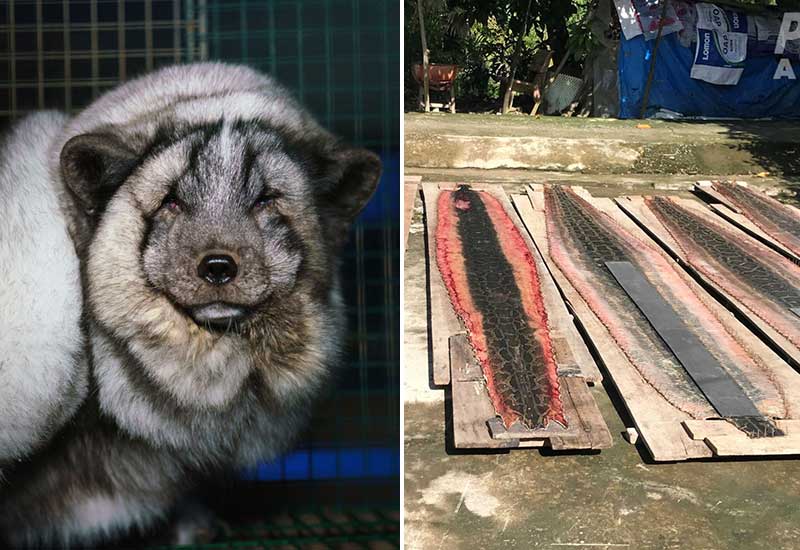
All animals that are caught, kept or bred for our textiles and garments have to suffer. After all, you can't take the body parts of someone who clearly doesn't want you to.
The list of animals in the fashion and textile industry is endless. However, I would like to list some of them here, which are preferentially captured worldwide or systematically exploited so that we humans can make seemingly useful or luxurious things out of their body parts.
The following animals suffer for...
Leather:
- Cattle
- Horses
- Donkey
- Buffalo
- Kangaroos
- Crocodiles
- Chamois
- Elephants
- Ostriches
- Snakes
- Fish (e.g. eels, cods, rays or sharks)
- Dogs (also for fur)
- Cats (also for fur)
- …
Fur:
- Minks
- Tanuki
- Foxes
- Otter
- Badgers
- Raccoons
- Weasel
- Lynxes
- Seals
- Squirrel
- Hamster
- Rabbit
- Chinchillas
- …
Wool:
- Sheep
- Goats
- Alpacas
- Camels
- Llamas
- Beaver
- Yak
- …
Down:
- Geese
- Ducks
- …
Silk:
- Caterpillars
- …
Basically, this list has no end. By the way, it's not only the animals that are exploited for their skin, feathers or fur that suffer. Among the Exhaust fumes, wastewater and toxins coming from textile factories leaks into the air, soaks into the soil, or is discharged into rivers, all animals suffer. This, too, is a man-made accelerator of the Species extinction.
Can you think of other animals that are captured or bred for fashion or textiles? Then feel free to drop me a note in the comments column.
What can everyone do for animals in the fashion industry?
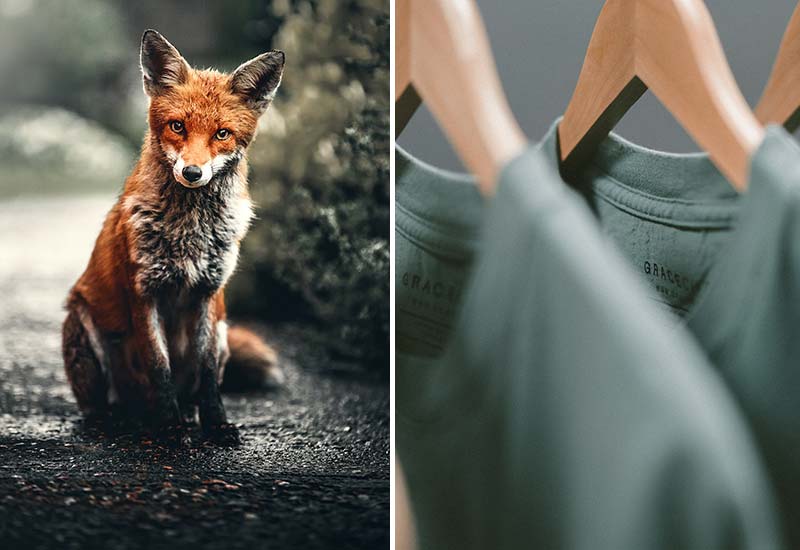
Actually, there should be no "animals in the fashion industry" at all. Anyone who really stands up against cruelty to animals and animal suffering will see it similarly. But this problem will not simply disappear overnight. We must adapt our behavior and learn, to consciously consume fashion and textiles for which animals play no role in the manufacturing and production process. Then fashion labels and retailers will focus more and more on animal-friendly garments.
Now I would like to give you some tips along the way, which both vegans and all non-vegans should take to heart.
Pay attention to product seals
It is incredibly difficult to assess whether or not a piece of clothing or textile is free of animal materials. However, with the "PETA-Approved Vegan" Seal, also a pretty clear identifier of animal-friendly products. It helps you to recognize vegan textiles faster. Whether it's fashion, accessories or interior design - the respective product is free of leather, wool, silk, fur, as well as animal glue and animal color.
Shop with brands that stand up against animal suffering
There are certain fashion brands that deliberately ensure that their products are made without animal suffering. For example, communicates Cecil, that the clothing produced and offered by the company is is absolutely (real) fur free.
Whether fashion store or individual brands - eventually you have your favoritesso that your next vegan shopping experience will be much easier for you.
Prefer artificial alternatives
Of course, it is best not to even wear the products that look like animal origin anymore. After all, in this way you would ensure that the Social acceptance still present remains.
But if you absolutely want to wear leather, silk, wool or fur, at least switch to the deceptively real, animal-friendly, plant-based or man-made alternatives. These include, for example:
- Leather from pineapple, mushrooms, paper, cacti or cork
- Silk from soy, cactus or lotus flower roots
- Wool made of cotton, bamboo, hemp or linen
- Fur made of cotton and synthetic polyacrylic pile yarn
Also for down there is with Bamboo, kapok or hemp also animal-friendly synthetic insulation materials that can keep you warm.
Tip: How you Distinguish genuine leather and imitation leather or Recognize and avoid real fur you can find out in the respective linked articles.
Support the work of animal welfare organization
From this article dz see that everyone in the Do something for the protection of animals in everyday life can. However, sometimes you don't have the time to get really active and, for example, go out on the street. In such cases, a donation to one of the many animal welfare organizations who are passionate about animal rights on a daily basis. Your financial support is welcome and put to good use in any case at PETA Germany, at the Albert Schweitzer Foundation or at the Animal Welfare Association.
Animals have no place in the clothing and textile industry
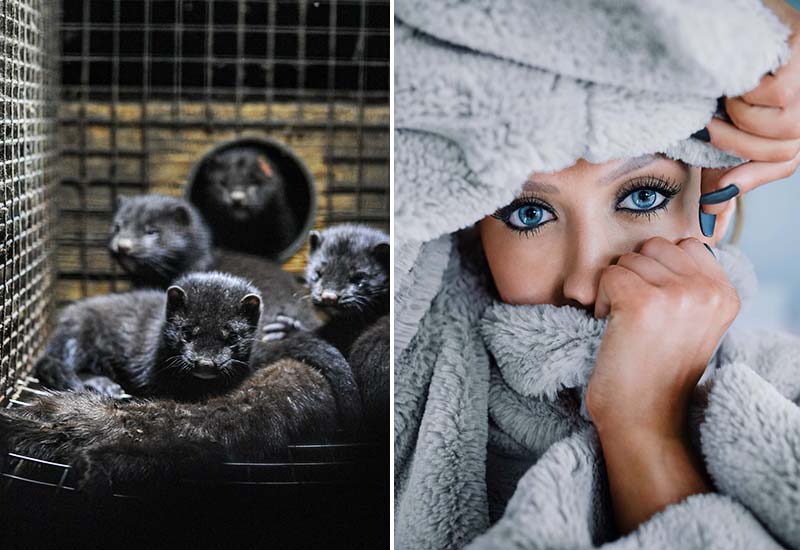
So there are also sensible, plant-based or synthetic alternatives that mimic animal fabrics without causing animal suffering. But since it's hard to tell them apart, you only have an absolute guarantee of animal-free clothing if you avoid leather, silk, down, fur or wool.
I hope that I could sensitize you with this article for the animal suffering in the textile industry. In any case, I have renounced brutal images of situations that are unfortunately commonplace in the industry. So if you are not yet completely convinced to go for vegan clothing and home textiles in the future, I recommend you to read both the Documentaries "Dominionas well as "true cost".
Do you have questions, tips or suggestions about this article about animals that are exploited and tortured in the fashion and textile industry? Then feel free to write me a comment!
Be always kind to animals,

PS.: Can animals actually laugh like we humans do? You'll find out the answer now in the next article!
References:
₁ Albert Schweitzer Stiftung für unsere Mitwelt: Leder - Tierleid und Umweltverschmutzung (Status: 21.08.2016), available at https://albert-schweitzer-stiftung.de/aktuell/leder-tierleid-und-umweltverschmutzung. [10.10.2022].
₂ animal public e.V.: Facts and figures on fur, available at https://t1p.de/petg. [12.08.2021].
₃ Welttierschutzgesellschaft e.V.: Down - plucked suffering (as of 26.11.2020), available at https://welttierschutz.org/daunen/
₄ PETA Deutschland e.V.: Mulesing - Lambs torturously mutilated for merino wool (as of 26.09.2022), available at https://www.peta.de/themen/mulesing. [12.08.2021].

